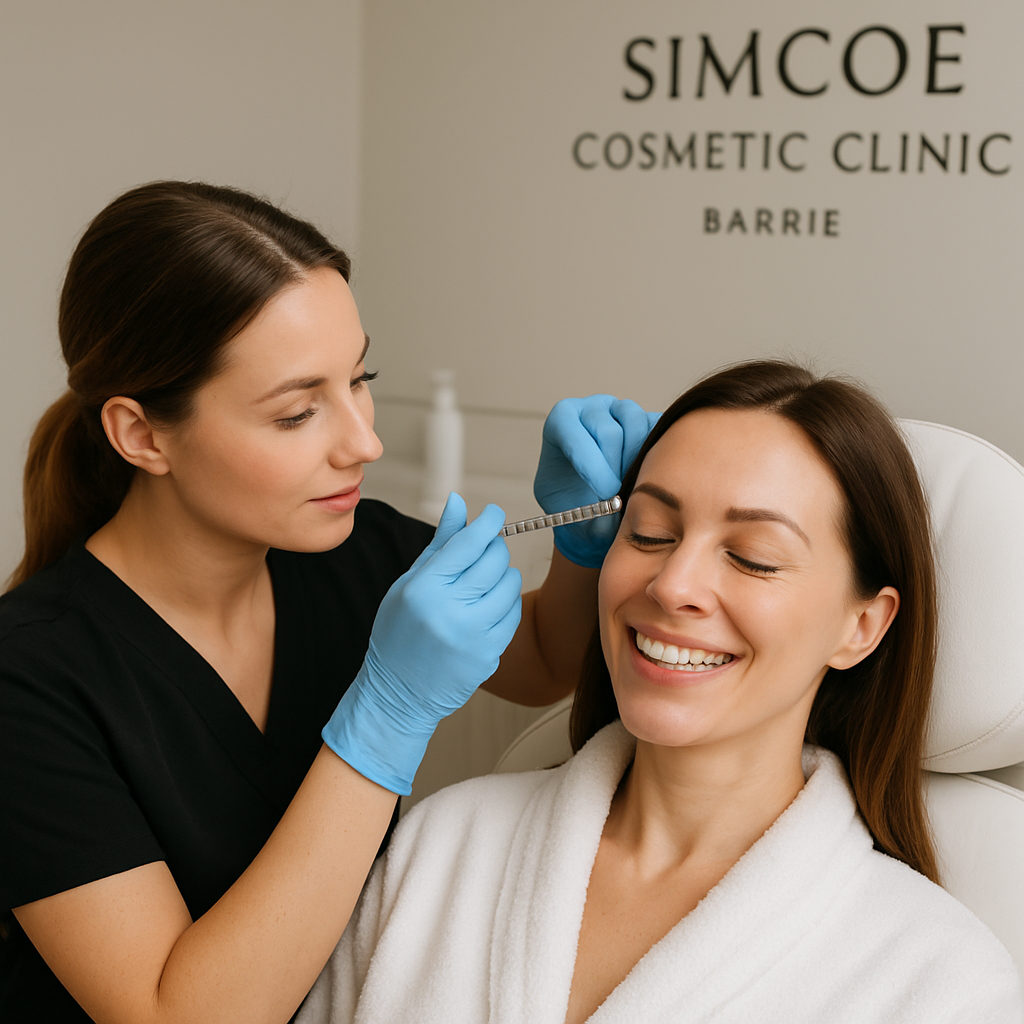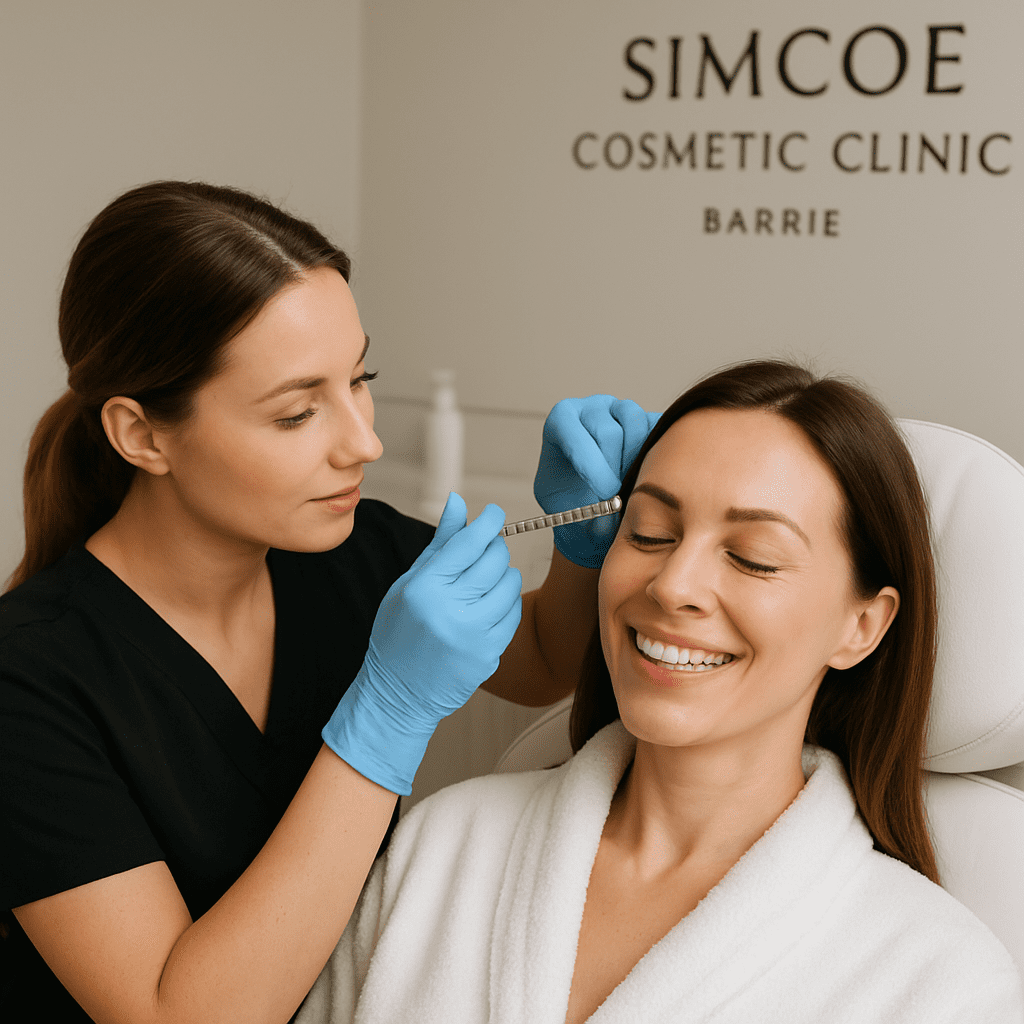You’ve probably heard a lot about Botox and Juvederm, right? These two names often come up when folks are thinking about refreshing their appearance without surgery. But what exactly sets them apart? How do you decide which is the best fit for you? It’s a common question, and a totally valid one.
Both Botox and Juvederm are popular treatments at places like Simcoe Cosmetic Clinic, designed to help you look younger and smoother in different ways. Botox works by relaxing the muscles that cause wrinkles, especially around the forehead and eyes. Juvederm, on the other hand, is a dermal filler that restores volume and fullness to areas like the cheeks, lips, or deeper facial lines.
So, how do you know which treatment suits your goals? Are you after softening fine lines from muscle movement, or do you want to plump areas that have lost volume with age? Understanding the distinct effects can make a huge difference in the results you get and how natural you look afterward.
Also, what about the duration of results, recovery time, or even the subtle differences in the procedure itself? Knowing what to expect can help ease any concerns and empower you to make the smartest choice for your unique look.
Curious to see how these treatments compare side-by-side? Interested in real advice from experts who know the local scene? We’ll break down the essentials so you can make an informed decision without feeling overwhelmed. Whether you’re new to aesthetic treatments or considering a touch-up, this guide has you covered.
Ready to dive deeper into the world of cosmetic rejuvenation? Discover the full scoop on Botox Barrie treatments and get expert insights to help you start your journey with confidence. Let’s explore the Botox vs Juvederm debate together and find out how to reclaim that youthful glow on your terms.
TL;DR
Wondering whether Botox or Juvederm suits your rejuvenation goals? Botox relaxes muscles to smooth wrinkles, while Juvederm restores volume for plumper, youthful contours. Both offer quick, non-surgical options with different effects and durations—understanding these differences helps you choose what fits your look best.
Understanding Botox: How It Works and Common Uses
If you’re exploring options for facial rejuvenation, you’ve likely wondered exactly how Botox works and what it can really do for you. Let’s peel back the curtain and dive deep into the science behind Botox and reveal why it’s one of the most popular treatments at Simcoe Cosmetic Clinic.
How Does Botox Actually Work?
Botox is a purified neurotoxin derived from Clostridium botulinum bacteria. While the word “toxin” might sound scary, rest assured that the amount used in treatments is minuscule and incredibly safe when administered by trained professionals.
Simply put, Botox works by blocking nerve signals to specific muscles. What does that mean for your skin? When muscle movement is temporarily weakened or relaxed, it smooths out the wrinkles and fine lines caused by those repeated expressions.
Ever notice those persistent frown lines between your eyebrows or crow’s feet around your eyes? Those are prime areas where Botox stops muscle contractions. Think of it as a gentle pause button on the muscles responsible for aging signs.
Common Cosmetic Uses of Botox
At the Simcoe Cosmetic Clinic, the primary goal of Botox is to help you look naturally refreshed without the downtime of surgery. Here are some of the most frequent concerns Botox targets:
- Forehead Lines: Sagging or deep horizontal creases can give you a tired look. Botox relaxes forehead muscles to smooth these lines.
- Glabellar Lines: These are the vertical “11” lines between your eyebrows caused by frowning. Botox softens their appearance effectively.
- Crow’s Feet: Wrinkles around the outer corners of the eyes that become more noticeable when you smile or squint.
- Neck Bands: Botox can also relax the vertical bands that appear in the neck, contributing to a more youthful profile.
But here’s the kicker—not everyone realizes that Botox is not only a cosmetic solution. It has therapeutic applications too.
Beyond Beauty: Therapeutic Applications of Botox
Did you know Botox is widely used in dental and medical fields to treat chronic conditions? For instance, dentists are increasingly administering Botox to relieve troublesome TMJ disorders and chronic jaw clenching (learn more about this therapy).
By relaxing the muscles responsible for grinding and tension, Botox can ease discomfort and headaches linked to TMJ dysfunction. Many patients experience dramatic relief with just a few strategically placed injections.
Additionally, Botox treats other medical issues like chronic migraines and hyperhidrosis (excessive sweating), highlighting its versatility.
How Long Does Botox Last?
One of the questions we get the most: “How long will my Botox results last?” Typically, the effects develop over a few days to a week post-treatment and last around three to four months. After that, muscle activity gradually returns, and you’ll need follow-up injections to maintain the smooth, youthful look.
Since Botox doesn’t add volume or change skin texture, many people combine it with dermal fillers like Juvederm in a personalized rejuvenation plan. Curious about what’s best for you? Understanding Botox vs Juvederm can guide you in choosing the right treatment—or even a combination that fits your unique goals.
Wondering if Botox is right for you? A consultation at Simcoe Cosmetic Clinic offers a personalized evaluation to discuss your concerns and design a treatment plan that feels comfortable and effective.

Exploring Juvederm: Types, Benefits, and Applications
If you’ve been considering a non-surgical facial refresh, Juvederm is likely on your radar. It’s one of the top choices when you want to restore youthful volume or soften wrinkles without downtime. But what makes Juvederm so popular, and how does it compare when you’re weighing your options for treatments like Botox? Let’s take a deep dive into what Juvederm offers.
What Is Juvederm?
Juvederm is a collection of FDA-approved dermal fillers primarily made from hyaluronic acid (HA), a substance naturally found in your skin. This gel-like filler works by adding volume beneath the surface, smoothing lines, enhancing contours, and hydrating the skin. Unlike Botox, which relaxes muscles to reduce wrinkles caused by movement, Juvederm fills and lifts areas to restore fullness and shape.
You may be surprised how many different formulations Juvederm has — each designed for precise facial areas and concerns. For example, Juvederm Vollure XC is often used for softening smile lines, while Juvederm Voluma XC adds volume to cheeks, giving a natural lift that can redefine your facial contours.
Types of Juvederm Fillers and Their Uses
Choosing the right Juvederm product comes down to your aesthetic goals. Here’s a quick breakdown of some popular Juvederm fillers:
- Voluma XC: Adds volume to cheeks and chin, perfect for combating age-related sagging and hollowing. Results can last up to a year.
- Vollure XC: Smoothes moderate to severe facial wrinkles, especially nasolabial folds (smile lines), with a subtle, natural look that lasts up to 18 months.
- Volbella XC: Targets delicate areas like lips and under eyes, useful for gentle lip enhancement or reducing hollowness below the eyes with up to a year of results.
- Ultra XC: Designed for adding plumpness to lips or softening deeper wrinkles.
- Volux XC: Helps redefine the jawline for a sculpted, youthful appearance.
Wondering why there’s so many types? That’s because each formula is uniquely structured to match the thickness, elasticity, and injection depth needed for different parts of your face, ensuring natural, balanced results without overfilling.
Benefits of Juvederm
Juvederm’s main appeal lies in how it instantly elevates your look—results are visible immediately after treatment, with minimal discomfort and virtually no downtime. You’ll often hear patients say, “Why didn’t I do this sooner?” after seeing how smooth their lines become and how lifted their features appear.
Since it’s made from hyaluronic acid, Juvederm also attracts moisture, promoting hydration and providing a subtle radiance. The body naturally breaks it down over time, so if you’re new to fillers, it offers a gentle introduction to facial enhancement without long-term commitment.
But here’s a question many ask: Is Juvederm safe? When administered by an experienced provider, like at Simcoe Cosmetic Clinic, Juvederm treatments are very safe with low risk of side effects, mostly limited to minor swelling or bruising that fades in a few days.
Common Applications of Juvederm
Juvederm can tackle a wide range of concerns, including:
- Smoothing smile lines and marionette lines
- Restoring volume in cheeks, temples, and chin for better facial symmetry
- Plumping and defining lips—whether you want a subtle boost or a bolder pout
- Reducing hollowness under the eyes for a refreshed appearance
- Enhancing or reshaping the jawline for a more youthful contour
Because of these versatile applications, Juvederm often pairs beautifully with treatments like Botox. While Botox addresses dynamic wrinkles by relaxing muscles, Juvederm replaces lost volume—making them a dynamic duo for comprehensive rejuvenation. Curious how these two work together? Check out our insights on Botox vs Juvederm to see what might suit your unique goals best.
Thinking about taking the plunge with Juvederm? A personalized consultation is key. Your provider can analyze your facial structure and recommend the right Juvederm formulations and injection techniques to create natural-looking results tailored just for you.
Ready to explore your options or curious about pricing and realistic expectations? Many patients find their Juvederm treatments range from moderate to advanced levels, but it’s always best to talk directly with your medspa expert for a clear plan and cost estimate.
To learn more about the various Juvederm fillers and their benefits, you can visit the official Juvederm website or explore this comprehensive guide on injectable fillers from the American Board of Cosmetic Surgery. These resources help clarify what to expect and why Juvederm remains a trusted treatment in facial rejuvenation.
Comparing Botox vs Juvederm: Key Differences and Similarities
You might be wondering: when it comes to wrinkle treatments, how do Botox and Juvederm really stack up? Both are popular at Simcoe Cosmetic Clinic, but they work quite differently and serve distinct purposes. Understanding these nuances helps you choose the best option for your unique needs. Let’s break down the key differences and similarities to clear up any confusion.
How Botox and Juvederm Work: Relaxing vs. Replenishing
Botox is a neurotoxin that temporarily relaxes the muscles that cause dynamic wrinkles—those lines that form when you frown, squint, or laugh. By blocking nerve signals, Botox smooths these expressions’ lines, especially around the forehead, crow’s feet, and frown lines. It’s not about adding volume; it’s about freezing movement that causes wrinkles.
Juvederm, on the other hand, is a hyaluronic acid-based dermal filler. It works by adding volume beneath the skin to fill in static wrinkles and folds—like smile lines or sunken cheeks. Since hyaluronic acid attracts and retains moisture, Juvederm also boosts hydration, helping the skin look plumper and more youthful immediately after treatment.
So, think of Botox as muscle relaxer and Juvederm as volume replacer. They’re complementary in many cases, often combined for a total facial refresh.
Speed of Results and Longevity: Instant Fill vs. Gradual Soften
If quick results sound appealing, Juvederm often wins here with effects visible immediately after treatment. Because it’s a gel-based filler, you can literally see the volume restored minutes after injections. Depending on the formula used and your skin area, these results can last from 12 to 24 months. Some people enjoy their Juvederm refreshers only once a year or so to maintain their look.
Botox, meanwhile, takes a little patience. Results usually start to show within 24 to 48 hours, with the full wrinkle-smoothing effect becoming apparent after about two weeks. The effects generally last three to four months, which means regular maintenance sessions are needed to keep wrinkles relaxed and skin smooth.
Are you looking for a quick fix or a gradual improvement? This timeline difference often guides many clients’ choices.
Cost Considerations: Investment vs. Maintenance
Budget plays a big role when deciding between Botox vs Juvederm. Generally, Juvederm treatments tend to be more expensive per session because of the longer-lasting effects and the cost of the filler itself. In Canada and places like Barrie, Juvederm treatments can range higher depending on the product variant and treated areas.
Botox is usually more affordable per session but requires more frequent visits every few months. Since Botox is charged per unit, the total cost depends on how many injections you need. If you want to soften multiple areas, your total price will increase accordingly.
Keep in mind—both treatments at Simcoe Cosmetic Clinic are performed by licensed medical professionals, so you’re investing in safety, expertise, and optimal results. Sometimes spending a bit more on Juvederm upfront saves you from more frequent Botox appointments down the line.
Safety and Side Effects: What to Watch For
Both Botox and Juvederm are FDA-approved and generally safe when administered by experienced providers. Common side effects like slight bruising or swelling happen but typically resolve quickly.
Juvederm’s hyaluronic acid is naturally found in your skin, which lowers allergy risks. However, rare complications can occur if injections aren’t done properly, making a qualified clinician essential. Some patients might experience redness or tenderness around the injection site.
Botox side effects might include minor headache or temporary muscle weakness nearby. Very rarely, the toxin can spread beyond the targeted area, which is why precise dosing and placement matter. Botox is not recommended during pregnancy or for people with certain neuromuscular conditions.
Curious about safety details? You can read expert insights on treatment risks and benefits at Healthline’s overview of Juvederm and Botox.
Suitability: Who’s a Good Candidate?
Most adults in good health are candidates for both treatments, but there are some exceptions. Juvederm is great for those wanting to restore volume and contour features like the lips, cheeks, or tear troughs. It’s especially helpful for deeper wrinkles and volume loss that Botox doesn’t address.
Botox suits people looking to minimize dynamic lines caused by facial movement. It’s often used preventively by younger adults or for those who want to reduce wrinkles without adding volume. However, Botox is generally not recommended for pregnant or breastfeeding women.
Wondering which treatment fits your lifestyle? Booking a consultation at Simcoe Cosmetic Clinic is your best bet to get an expert, personalized recommendation.
Key Comparisons at a Glance
| Feature | Botox | Juvederm | Notes |
|---|---|---|---|
| Primary Function | Relaxes facial muscles to reduce dynamic wrinkles | Fills in wrinkles and restores facial volume | Targets different wrinkle types; complementary when combined |
| Onset of Results | 24-48 hours; full effect in ~2 weeks | Immediate visible results post-injection | Speed varies; Juvederm acts faster |
| Duration of Effects | 3-4 months | 12-24 months | Juvederm requires less frequent touch-ups |
| Cost | Generally lower per session; needs more frequent treatments | Higher per session; longer-lasting results | Depends on treatment area and volume |
| Common Side Effects | Minor bruising, headache, muscle weakness | Swelling, redness, tenderness at injection site | Both have low risk when done by experts |
Still on the fence about Botox vs Juvederm? Combining them often gives the best of both worlds—softening lines with Botox and restoring youthful volume with Juvederm. Many clients report this “dynamic duo” approach gives a natural, refreshed look without surgery.
For personalized advice tailored to your skin and goals, schedule a consultation with Simcoe Cosmetic Clinic’s experienced team. Understanding these differences puts you firmly in control of your rejuvenation journey.
Explore trusted professional resources like the American Board of Cosmetic Surgery’s injectable filler guide for in-depth info, too.
Whether you want to smooth wrinkles, restore volume, or both, the key is expert care that ensures safe, beautiful results you’ll love seeing in the mirror.
How to Decide Which Treatment Is Best for Your Aesthetic Goals
So, you’re considering injectable options to look younger but aren’t sure where Botox ends and Juvederm begins? Let’s break it down so you can feel confident choosing the best treatment to match your unique goals.
Identify Your Primary Concern
Start by pinpointing what bothers you most about your appearance. Are dynamic wrinkles—those caused by muscle movement like frown lines and crow’s feet—your top priority? Botox excels at relaxing these muscles to smooth out those expression lines.
On the other hand, if your goal is volume restoration—think plumping cheeks, lips, or filling in deep folds—Juvederm, a hyaluronic acid-based dermal filler, is more suitable. It adds youthful fullness where loss has occurred.
Consider Treatment Longevity and Maintenance
How long do you want the results to last? Botox’s effects typically last around 3-4 months, making it a good option if you prefer fine-tuning results regularly or are new to injectables. Juvederm results can last closer to 12-24 months depending on the specific product used, ideal if you’re looking for longer-lasting volume enhancement.
Keep in mind touch-ups and scheduling—Botox sessions need more frequent maintenance, while Juvederm requires fewer but possibly higher upfront costs.
Think About Which Facial Areas You Want to Treat
Botox is FDA-approved for upper face areas such as forehead lines, glabellar lines between the eyebrows, and crow’s feet. Juvederm is better suited for mid-face to lower face treatments like cheeks, nasolabial folds, marionette lines, and lips.
Another tip: Some patients benefit from a combination of both Botox and Juvederm to achieve natural, balanced rejuvenation. This approach relaxes wrinkles and restores volume simultaneously, perfect if you want comprehensive yet non-surgical results.
Assess Your Budget and Comfort Level
Budget plays a role, too. Botox treatments tend to be less expensive per session but need more frequent visits. Juvederm costs more initially but spaces out treatments. Discussing these factors openly with your provider helps tailor a plan that fits your lifestyle and wallet.
Also, reflect on your comfort with needles and downtime. Both treatments are quick, minimally uncomfortable, and have little to no recovery time. Knowing this can ease any anxiety going in.
Consult with Expert Providers for Personalized Guidance
There’s no one-size-fits-all answer for Botox vs Juvederm. The best way to decide is through a detailed consultation with experienced professionals who understand facial anatomy and your personal goals. At Simcoe cosmetic clinic, our expert team can recommend a treatment plan uniquely right for you.
Don’t just take our word for it—review educational insights like the University of Utah Health’s guide on Botox vs fillers to deepen your understanding and set realistic expectations.
Still curious about local options and expert tips? You might find our expert insights on Botox in Barrie helpful for discovering treatments tailored to real people in your community.
Final Thoughts: Your Aesthetic Journey Starts Here
Remember, the goal is to enhance your natural beauty, not to mask it. By clearly defining your priorities, understanding treatment differences, and consulting trusted professionals, you set yourself up for results you’ll love.
So, what should you do next? Schedule a consultation to get personalized advice and start your rejuvenation journey with confidence.

What to Expect During and After Botox and Juvederm Procedures
Thinking about Botox vs Juvederm? Both procedures are fairly quick and convenient, but what really happens during your appointment—and right after—can shape your experience and satisfaction.
During the Procedure: Quick, Precise, and Comfortable
At Simcoe cosmetic clinic, skilled providers tailor each session based on your facial anatomy and goals. Botox treatments typically involve just a few tiny injections targeting muscles responsible for wrinkles. The process usually takes 10 to 15 minutes.
Juvederm, on the other hand, uses hyaluronic acid fillers to instantly add volume, smooth deep lines, or enhance features like lips. Depending on the area, expect 15 to 60 minutes in the treatment chair. Both treatments are minimally invasive, so most patients say the discomfort is minor—think quick pinches rather than pain.
Curious if you need anesthesia? Usually, topical numbing cream is enough to keep you comfortable, especially with Juvederm injections.
Immediate Post-Treatment: What You Might Notice
Right after injections, it’s common to experience mild redness, swelling, or slight bruising around the treated areas. This is normal and typically resolves within a few days. Your provider might offer a cool compress to soothe any tenderness and help reduce swelling.
Have you wondered if you can wash your face or apply makeup right away? Good news: you can gently cleanse and even wear makeup shortly after treatment, but it’s best to avoid harsh rubbing or pressing the injection sites for at least 24 hours.
Some folks ask if facial expressions interfere with results. Feel free to smile, frown, or move your face naturally—studies show normal movement doesn’t negatively impact Botox or Juvederm effectiveness.
Recovery and Results Timeline: Patience Pays Off
One crucial difference between Botox and Juvederm is when you see results. Botox typically takes a few days up to a week to fully kick in as it gradually blocks muscle activity to smooth dynamic wrinkles. Juvederm offers immediate results by physically filling lines and enhancing volume, but minor swelling may mask the final look for a few days.
During the first week post-treatment, swelling and bruising should diminish. Keep an eye on your skin and follow any specific aftercare your provider recommends. Avoid aggressive facial massages or treatments like facials for at least 24 hours after Botox, and longer if swelling persists.
Wondering if exercise is off-limits? Moderate workouts are generally fine after these treatments. Some suggest waiting a few hours to reduce bruising risk, but strict exercise avoidance isn’t necessary.
Long-Term Care: Keeping Your Glow Fresh
Both Botox and Juvederm require maintenance sessions to sustain desired effects—usually every 3 to 6 months for Botox and 6 to 12 months for Juvederm, depending on the product and treatment area.
Protect your refreshed skin by incorporating sunscreen daily and staying hydrated. For Juvederm, avoid excessive sun exposure immediately after treatment to minimize irritation or pigment changes.
Got more questions or concerns? Your best bet is a detailed consultation with experts who know how to maximize your results safely. The team at Simcoe cosmetic clinic can walk you through personalized aftercare to ensure your journey looks natural and feels comfortable.
If you want to dig deeper into expert advice on injection aftercare, the Cleveland Clinic offers great insights on Botox aftercare. And to understand what’s typical after Juvederm, check out this detailed post on Juvederm recovery timelines.
So, ready to embrace a smoother, more youthful look? Knowing exactly what to expect during and after your Botox and Juvederm procedures can make all the difference. Remember—choosing experienced professionals and following a proper aftercare routine set you up for success on your aesthetic journey.
Potential Side Effects and Risks of Botox and Juvederm
When deciding between Botox vs Juvederm, it’s crucial to understand not only the benefits but also the possible side effects and risks tied to each treatment. Both are generally safe when administered by skilled professionals, like those at Simcoe cosmetic clinic, but knowing what to watch out for can make your experience smoother and stress-free.
Botox: What Could Possibly Go Wrong?
Botox works by temporarily relaxing muscles to smooth dynamic wrinkles. Most side effects are mild and short-lived. You might notice minor redness, swelling, or bruising around the injection sites, which usually fade within a few days. Some clients report a slight headache or temporary eyelid drooping — though these are rare and typically resolve without intervention.
More serious complications are extraordinarily uncommon but can include muscle weakness near the treatment area or difficulty swallowing if the toxin spreads beyond the target site. That’s why it’s critical to choose a certified injector who understands facial anatomy inside out. Experts from Simcoe cosmetic clinic recommend discussing your full medical history upfront, especially if you have neuromuscular disorders or are pregnant, as Botox isn’t advised in those cases.
Juvederm: Risks Behind the Filler
Juvederm is a versatile dermal filler designed to restore volume and smooth static wrinkles. After your treatment, swelling, redness, and mild bruising at injection sites are quite typical — they usually settle within a week. Some clients might experience tenderness or a small lump under the skin, which often resolves on its own.
Serious risks with Juvederm revolve mainly around accidental injection into a blood vessel. This rare event can cause tissue damage, leading to skin necrosis or more severe consequences like vision impairment. That’s why treatment must be done by an experienced provider familiar with facial vascular anatomy. According to FDA guidelines, always ensure you’re tested for allergies if your filler contains animal-based components and immediately report any unusual pain or prolonged discoloration after your procedure.
Weighing Botox vs Juvederm: What Should You Consider?
Both treatments share common mild side effects like bruising and swelling, but they differ in mechanisms and risks. Botox’s effects stem from muscle relaxation, sometimes causing temporary localized weakness, while Juvederm physically adds volume, presenting unique vascular risks.
So, how do you decide which is right for you? It all boils down to your desired results and health background. For example, if you want to soften expression lines with minimal downtime, Botox might be your go-to. If volume loss is your primary concern, Juvederm offers a natural plumpness but with a slightly higher risk profile.
At Simcoe cosmetic clinic, your safety is top priority. Our expert injectors carefully evaluate your anatomy, medical history, and aesthetic goals to minimize risks and customize your treatment plan. They also provide clear aftercare instructions to help you avoid complications and enjoy the best possible results.
Curious to learn more about Botox’s safety specifics? Check out detailed insights from Simcoe Cosmetic Clinic’s Botox guide. For a thorough explanation of dermal filler risks and precautions, the FDA’s consumer safety page is an excellent resource.
Your aesthetic journey with Botox vs Juvederm is a partnership. Ask questions, share concerns, and pick an experienced provider to help you shine safely and confidently.
Conclusion
Choosing between Botox vs Juvederm isn’t just about picking a product—it’s about understanding your unique needs and goals. Both treatments offer effective ways to rejuvenate your appearance, yet they work in fundamentally different ways. Botox relaxes muscles to smooth wrinkles, making it ideal for expression lines. Juvederm restores lost volume, plumping skin for a more youthful look.
So, how do you decide? Consider what you want to achieve and your tolerance for downtime or potential side effects. Are you after subtle wrinkle softening or noticeable facial volume restoration? This clarity will guide you toward the right choice.
At Simcoe Cosmetic Clinic, we’re committed to tailoring treatments specifically for you. Our experienced team evaluates your anatomy, medical history, and aesthetic goals to design a safe, effective plan. This personalized approach not only minimizes risks but helps you get the best results possible.
Remember, your journey to a refreshed look doesn’t stop at the treatment chair. Following the recommended aftercare and consulting your provider whenever questions arise are crucial steps toward long-lasting satisfaction.
Ready to take the next step? Whether it’s Botox or Juvederm, trust in expert guidance and informed decisions to confidently embrace a younger, vibrant you.
Frequently Asked Questions (FAQ) About Botox vs Juvederm
What is the main difference between Botox and Juvederm?
Botox and Juvederm serve different but complementary purposes in facial rejuvenation. Botox works by relaxing facial muscles that cause wrinkles, making it perfect for dynamic lines like crow’s feet and forehead wrinkles. Juvederm, on the other hand, is a dermal filler that restores lost volume and smooths static wrinkles, such as nasolabial folds or plumping lips.
Knowing this helps you pinpoint whether you want to soften expression lines or add youthful fullness.
How long do the effects of Botox vs Juvederm last?
Typically, Botox results last about 3 to 4 months. You’ll need regular treatments to maintain muscle relaxation and wrinkle reduction. Juvederm’s longevity varies by product type, but most results last from 6 months up to 18 months, depending on the area treated and your body’s metabolism.
Thinking about commitment? Juvederm might mean fewer touch-ups, but both require ongoing visits for best results.
Are there side effects to watch out for with either treatment?
Both Botox and Juvederm are generally safe when administered by experienced professionals, but side effects can occur. Botox might cause temporary bruising, mild swelling, or droopy eyelids if injected incorrectly. Juvederm can lead to redness, swelling, or lumps, which usually resolve within a few days.
Always communicate openly with your provider about your health history to minimize risks.
Can I get Botox and Juvederm treatments at the same time?
Absolutely! Many people combine both treatments for a comprehensive refresh—Botox for smoothing movement-related wrinkles and Juvederm for volume restoration. This approach ensures a balanced, natural look tailored to your facial anatomy.
Combining them efficiently cuts downtime and maximizes aesthetic benefits.
Which treatment is better for younger versus older skin?
If you’re just starting to notice fine lines, Botox might be the easier preventative step to delay deeper wrinkles. Juvederm is often preferred when you notice volume loss or deeper folds, commonly occurring with more mature skin.
Age isn’t the only factor—skin condition and your cosmetic goals really influence the right choice.
How do I choose a qualified provider for Botox vs Juvederm?
Choosing a trusted, experienced provider like the team at Simcoe Cosmetic Clinic is crucial. Look for licensed medical professionals who specialize in injectables, understand facial anatomy deeply, and customize treatments to your unique features.
Don’t hesitate to ask about their training, see before-and-after photos, and discuss your expectations openly.
What should I expect during recovery?
Both Botox and Juvederm have minimal downtime. You might experience slight redness, swelling, or tenderness for a day or two. Avoid strenuous activity, excessive heat, or touching the area immediately post-treatment to ensure the best results.
Being patient and following aftercare instructions helps you enjoy your refreshed look longer.
So, feeling ready to explore which option suits your aesthetic goals? Remember, at Simcoe Cosmetic Clinic, personalized consultations help you decide between Botox vs Juvederm for a natural, youthful transformation that fits your lifestyle.





